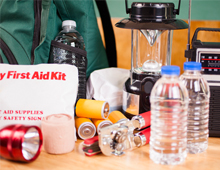Must Have Items for Your Home Emergency Kit
Published: 09/17/2019

YOUR 3-DAY EMERGENCY KIT
Natural or man-made disaster events can occur at any time. To assemble your 3-day kit, store items in airtight plastic bags and put your entire disaster supplies kit in one or two easy-to-carry containers such as plastic bins or a duffel bag
Consider the unique needs of you and your family, and add other items you may require. Keep emergency kits at home, and consider creating a portable kit for your vehicle and workplace. More information can be found at Ready.gov
What Should Be Included in Your Kit
Water: 1 gallon of water per person per day for at least 3 days, for drinking and sanitation (2-week supply, if possible)
Food: At least 3-day supply of nonperishable food (2-week supply, if possible)
Battery-powered or hand crank radio.
Flashlight and extra batteries
First aid kit and first aid book
Whistle to signal for help
Dust mask to help filter contaminated air
Plastic sheeting and duct tape to shelter-in-place
Moist towelettes, toilet paper, garbage bags and plastic ties for personal sanitation
Wrench or pliers to turn off utilities
Manual can opener for food
Cell phone with chargers and backup batteries
Prescription medications and non-prescription medications such as pain relievers, antidiarrhea medication, antacids or laxatives
Glasses, contact lenses and contact lens solution
Infant formula, bottles, diapers, wipes, diaper rash cream
Personal toiletries: soap, toothbrush and toothpaste
Pet food, medicine, and extra water for your pet
Cash (small denominations are best)
Important family documents such as copies of insurance policies, identification and bank account records saved electronically or in a waterproof, portable container
Sleeping bag or warm blanket for each person
Complete change of clothing appropriate for your climate and sturdy shoes
Household chlorine bleach and medicine dropper to disinfect water
Coffee filters, paper towels, and clean cloth to filter water.
Fire extinguisher
Matches in a waterproof container
Feminine supplies and personal hygiene items
Mess kits, paper cups, plates, paper towels and plastic utensils
Paper and pens (check ink)
Books, games, puzzles or other activities for children
Maintain your kit so it’s ready when you need it
Keep canned food in a cool, dry place.
Re-think your needs every year and update your kit as your family’s needs change.
Store boxed food in tightly closed plastic or metal containers (rotate food and keep track of expiration dates). Replace expired items.
To learn about ways to protect your home, family, and pets in the event of an emergency, click here:


